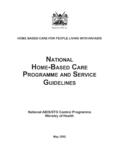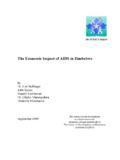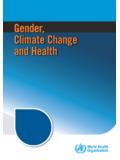Transcription of Stigma, Discrimination, Internal Stigma, and HIV
1 BREAKING THE cycle : stigma , discrimination , Internal stigma , and hiv . stigma , discrimination , put them at the forefront of strength- reviews the present understanding of and hiv IN 2006 ening effective responses to HIV. At HIV-related stigma and discrimination During the first few years of the 21st long last, academics, researchers, as they relate to vulnerability, and century, discussion of HIV and AIDS activists, service providers, and people suggests approaches for stigma shifted to a greater focus on related living with HIV are beginning to reduction. It explores and examines issues, such as stigma and discrimina- understand and articulate the conse- what constitutes HIV-related stigma tion, gender, and development. Recog- quences of addressing (or not address- and discrimination , what effects they nition of the significance of HIV- ing) and measuring HIV-related have on behavior and hiv responses, related stigma and discrimination has stigma and discrimination .
2 This paper and what we can do to reduce them. That doctor did not know much about what HIV was. I arrived at the appointment and he didn't touch me. I sort of expected that kind of reaction. Besides, physically I felt so bad that how could I fight with him. He sent me to one of the hospitals that had quite a few AIDS patients and the same thing happened with the nurses. One can't help but notice, by the way that they look at you, that you're being judged HIV is a big problem in our country because there is still a lot of ignorance related to the theme. Discriminatory attitudes and rejection of those living with HIV. persist; moreover health services are not really adequate. There is so much to do so as to take this disease seriously There are still many people with erroneous ideas about what HIV signi- fies. Sometimes I get so angry that people can be so insensitive. It is really troubling that people at risk of infection think that AIDS is something far away; that it could not happen to me.
3 Eugenio, diagnosed HIV positive in 1992. JANUARY 2006. This publication was produced for review by the United States Agency for International Development (USAID). It was prepared by Ken Morrison of the National Institute for PublicDISCRIMINATION, stigma , Health (Mexico) and the Internal POLICY. stigma , Project/1. and hiv . Mexico. The author's views expressed in this publication do not necessarily reflect the views of USAID or the United States Government. THE HISTORY OF ( , condoms), and the probability of risk. Situation refers to the actual UNDERSTANDING OF HIV encountering a partner who was circumstances and conditions related TRANSMISSION infected. In turn, this new awareness, to an event or occurrence. This might Over the past 25 years, we have seen combined with ideas of health promo- include the act undertaken, use of an evolution in our understanding of tion and human rights, caused us to alcohol or drugs, the state of mind of HIV (the virus), of the AIDS epi- look at HIV and AIDS in a whole new an individual at that point (being demic, and of the factors involved in light: that of vulnerability to depressed, desperate, or hiding), HIV transmission, prevention, and infection.
4 This was not so much a power relations in an encounter, care. When AIDS was first detected, it revolution in thinking, but a progres- immediate access to prevention was closely associated with certain sive appreciation over time. commodities, and the prevalence of sub-populations; epidemiologists HIV in the population or the probabil- identified and labeled them as risk ity of an encounter with someone who VULNERABILITY and hiv . groups. The enduring responses to is HIV positive. Combining these Vulnerability is a concept based on this labeling have been systematized three interconnected spheres presents notions of susceptibility to attack or stigmatization and distancing. People a much better sense of vulnerability or to being wounded. It includes aspects who did not identify with these groups the factors related to a person's related to risk, which in turn are did not see themselves at risk; those susceptibility to infection or to getting related to the source of danger, the that did identify with these sub- sick (see Figure 1).
5 Possibility of incurring misfortune, or populations, or were deemed to be in this case, the probability of becom- part of them, were ostracized and ing infected or falling ill. By combin- stigma AND. branded as perpetrators of infection. ing factors from an understanding of discrimination : EARLY. At that time, the source of an immune sociology and anthropology with CONCEPTUAL MODELS. system breakdown was unknown and those from psychology and epidemiol- stigma and discrimination are recog- responses were based primarily on ogy, we have a clearer understanding nized as two key factors that need to fear and conjecture. When HIV was of vulnerability. It can be explained, be addressed to create an effective and detected and deemed to be the source for example, by combining three sustained response for HIV preven- of infection, the enormous anxiety spheres of interaction: Society, self, tion, care, treatment, and impact associated with the unknown was and Each sphere is related mitigation.
6 The effects of HIV-related somewhat diminished. Over time, a to and reinforced by the other spheres. stigma and discrimination can be felt new understanding of transmission on many levels: individual, family, Society refers to the underlying factors community, programmatic, and arose and was defined as risk behav- ior. Ideas such as protected sexual that would influence self and situa- societal. They represent obstacles such activity and choice of sexual partners tion, including social, economic, as preventing individuals from being became part of our collective appre- cultural, and political aspects; access tested; preventing persons from to prevention and care services; recognizing that they or family ciation. Attention was shifted from community support networks; sources members are HIV positive; inhibiting persons to acts. of information; and, importantly, people from seeking care, support, Through the 1980s and into the 1990s, stigma and discrimination .
7 Self refers and treatment; causing people to as a result of behavioral studies, new largely to the capacity of an individual mislead others; impeding people from concepts of risk factors came into play to cope with different or difficult using protection in intimate relations;. and led to the reconceptualization of circumstances. This would include preventing quality care and treatment;. HIV regarding risk situations. This attributes and characteristics such as increasing social inequities; hindering insight took into consideration such knowledge, experience, self-esteem, the access of people living with HIV. factors as the influence of power self-acceptance, and life skills. These to housing, education, employment, relations, the use of alcohol, the are the factors that a person would and mobility; negatively affecting availability of preventive commodities bring to bear on any given situation of quality of life; and, eventually, leading 1.
8 This is the author's adaptation of work outlined by F. Delor and M. Hubert (2000). 2 stigma , discrimination , Internal stigma , and hiv . FIGURE 1. THE cycle OF VULNERABILITY: that HIV-related stigma reinforces SOCIETY, SELF, AND SITUATION existing social inequalities. Their framework outlined four priority issues for action: 1) improved under- standing of stigma and discrimination , where they come from, and what they do; 2) increased appreciation of links to broader existing inequities and SOCIETY SELF injustices; 3) better understanding of the complex stigma - and discrimina- tion-related issues that precipitate the VULNERABILITY epidemic; and 4) clear identification of objectives for results. As a response to the many challenges outlined above, the POLICY Project, funded by the Agency for International Development (USAID), undertook projects in two countries to foster SITUATION better understanding of and responses to HIV-related stigma and discrimina- to increased transmission, morbidity, to be very different in different areas tion.
9 And mortality. of the world. This led to a clear conclusion: The majority of those stigma and discrimination are inter- POLICY'S stigma . affected by HIV had one thing in acting aspects that are common in all MITIGATION INITIATIVES: common they were in some way or walks of life. While stigma refers to MO KEXTEYA AND SIYAM'KELA. another marginalized within society. the realm of attitudes and perceptions, This recognition caused Jonathan discrimination relates to action and Mann, then head of the Global Pro- behavior. The word stigma has gram on AIDS at the World Health Mo Kexteya: N huatl lan- Greek origins referring to the marks of Organization (WHO), to note that guage of Aztecs, connotes physical deformities of foreigners or there were really three phases of the persons deemed inferior. Christians similarity, comparability, and epidemic: the epidemic of HIV. gave this word a twist by using it to transmission, the epidemic of AIDS, likeness or to appear, to refer to the physical indications of the and, finally, the epidemic of stigma , come out, or to change.
10 Divine spirit. In modern times, stigma discrimination , and denial. emphasizes visibility and has been defined as an undesirable or discrediting attribute that an indi- UNAIDS, recognizing the vital empowerment. vidual possesses, thus reducing that importance of reducing HIV-related individual's status in the eyes of stigma and discrimination and ad- society (Goffman, 1963). It is a dressing HIV within a human rights Siyam'kela: Nguni word, framework, made this the theme of the meaning we are accepting . labeling of an individual or group as World AIDS Day Campaign for both different or deviant. or together we stand ;. 2002 and 2003. Parker and Aggleton2. In the late 1980s and into the 1990s, provided a basis for action in this emphasizes the need for there was a move to take a second, campaign by stressing that stigmatiza- unity and compassion. more detailed look at the global HIV tion is a process that works to produce epidemic that, until that point, seemed and reproduce power relations, and 2.















